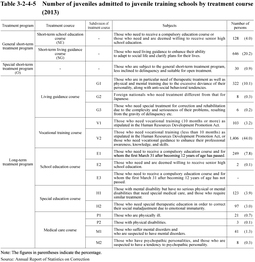2 Treatment provided in juvenile training schools
(1) Types of juvenile training schools and treatment programs
A. Types of juvenile training schools
The following four types of juvenile training schools are used to accommodate juveniles according to their age, level of criminal tendency, and physical and mental condition, etc. at the time of their admission:
[1] Primary juvenile training schools: Juveniles generally aged 12 or older but typically younger than 16 and without any serious physical/mental disabilities;
[2] Middle juvenile training schools: Juveniles generally aged 16 or older but younger than 20 and without any serious physical/mental disabilities;
[3] Special juvenile training schools: Juveniles generally aged 16 or older but younger than 23 and without any serious physical/mental disabilities but with strong criminal tendencies. However, juveniles younger than 16 sentenced to imprisonment can also be accommodated here; and
[4] Medical juvenile training schools: Juveniles generally aged 12 or older but younger than 26 and with serious physical/mental disabilities.
B. Treatment programs
Both short-term and long-term treatment programs are available at juvenile training schools, with the former being further divided into a general short-term treatment program and a special short-term treatment program. Primary juvenile training schools and middle juvenile training schools can implement both short-term and long-term treatment programs whereas special juvenile training schools and medical juvenile training schools only implement long-term treatment programs. Juveniles are placed to the respective programs as follows:
[1] General short-term treatment program: Juveniles who can be expected to be corrected and reintegrated back into society through continuous intensive short-term guidance and training as they are very likely to be promptly reformed (maximum term of confinement, in principle, of six months);
[2] Special short-term treatment program: Juveniles who fall under [1], but less inclined to delinquency, and who therefore are more suited to open treatment (maximum term of confinement of four months);
[3] Long-term treatment program: Juveniles who are not suitable for short-term treatment programs (maximum term of confinement, in principle, of two years).
The type of juvenile training school is designated by a family court following the ruling to commit them to a juvenile training school. In addition, a family court can recommend short-term treatment programs upon that ruling if deemed appropriate, in which case the treatment program is then determined in accordance with that recommendation. In all other cases, the juveniles receive long-term treatment program.
Table 3-2-4-4 shows the number of juveniles newly admitted to juvenile training schools in 2013 by type of juvenile training school and treatment program.
Table 3-2-4-4 Number of juveniles admitted to juvenile training schools by type of juvenile training school and treatment program (2013)
C. Treatment courses
Treatment courses have been established for both the general short-term treatment program and the long-term treatment program (with further divisions of the treatment courses also being available within the long-term treatment program). All the juveniles in juvenile training schools are provided with guidance in five areas of correctional education, namely daily life guidance, vocational guidance, academic education, health and physical education, and special activities. However, each juvenile is assigned to one of the treatment courses, each of which places different priority on each of these five areas of correctional education, according to the criminal tendency, academic ability, future plans, and physical and mental condition of each juvenile to implement the treatment in the manner most effective (medical treatment has priority in the medical treatment course). The treatment course also notes the key matters that require attention in the course of implementing the correctional education.
Table 3-2-4-5 shows the type and subject of treatment courses, etc., along with the number of juveniles newly admitted to juvenile training schools by treatment course, etc. in 2013.
Table 3-2-4-5 Number of juveniles admitted to juvenile training schools by treatment course (2013)

